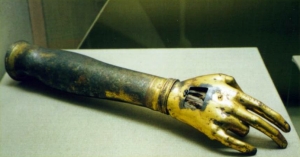| Material
remains of a martyr or saint or physical objects connected with the
life of such a person. |
 |
|
Reliquary
containing a saint's hand bones
|
The veneration of
relics in both the East and the West was early connected with the cult
of martyrs and later expanded to include the remaining body of Saints.
After the fourth century relics of saints
were often transferred from typical suburban burial sites to the sites
of the urban churches erected in the centuries after the conversion of
Constantine. It became the custom in the West to entomb relics in every
altar, and the ritual kissing of the altar by the celebrant before mass
was a gesture of veneration of these relics. The veneration of relics
in the East was comparatively limited due to infrequent canonization of
saints and the use of icons. In the medieval West, on the other hand,
the cult of relics flourished, especially in the era of crusades
when many relics both genuine and false were sent to the West from Palestine
and surrounding areas. Augustine of
Hippo and Thomas
Aquinas both contributed to a theological rationale for the veneration
of relics. They argued that the bodies of the saints were temples of the
Holy Spirit and claimed miracles associated with their relics.
|